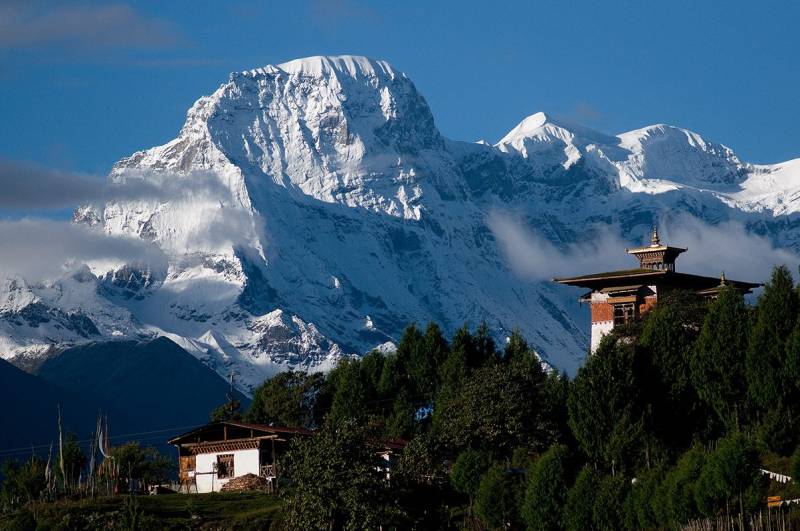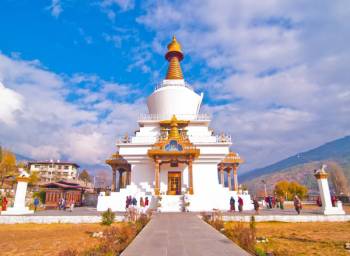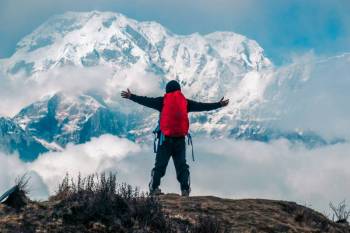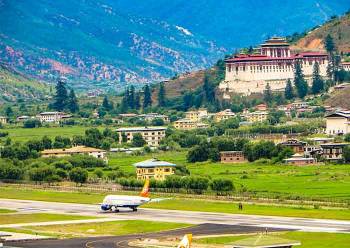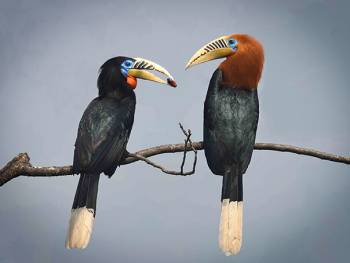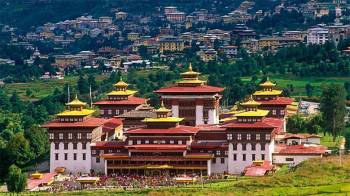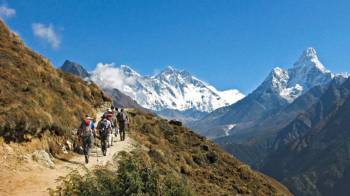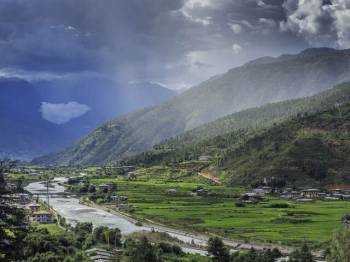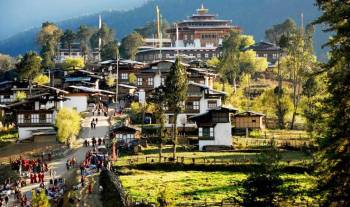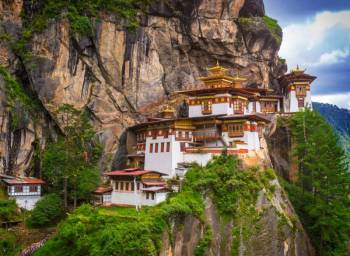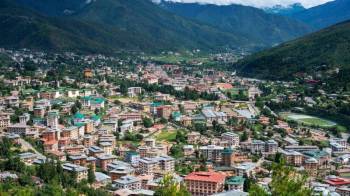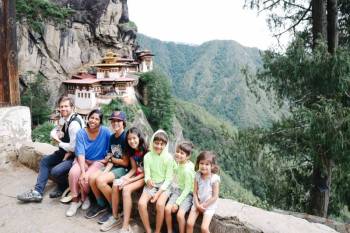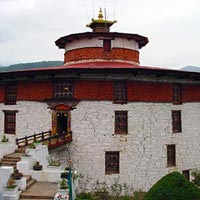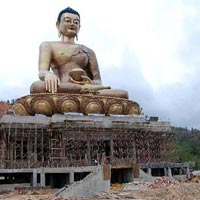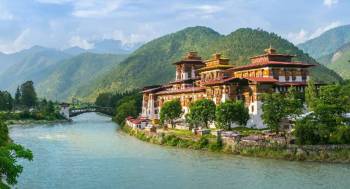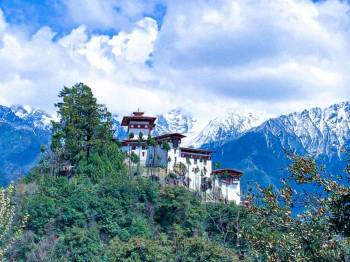22 Days 21 Nights To Lunana Package
Link Copied
Duration : 21 Nights / 22 Days
Destination Covered : Paro, Punakha
Tour Activities : Trekking, Museums, Sightseeing
Tour Themes : Hill Stations & Valleys, Religious & Pilgrimage, Culture & Heritage
Price on Request
Paro and Punakha Tour Overview
Arrival / Departure
Arrival: Paro International Airport
Departure: Paro International Airport
Paro and Punakha Tour Itinerary
Day 1
Welcome to Bhutan, the Land of the Thunder Dragon. Touching down at Paro International Airport, you will be greeted by your guide upon exiting the arrival hall. Today, we will take it easy to acclimatize to the altitude. Drive to Thimphu, check in to the hotel and let’s have your first taste of Bhutanese cuisine.
National Memorial Chorten – Meet the elderly generation in circumambulation.
Folk Heritage Museum – Dedicated to connecting people to the Bhutanese rural past though exhibition of artifacts used in rural households.
Textile Museum – Witnesses the art of traditional weaving.
Institute of Zorig Chusum – Commonly known as the Painting School, or the School of the Thirteen Arts, the Institute offers you a glimpse of novices learning 13 traditional arts and crafts of Bhutan. It is a hands-on trip for you. Enjoy few moments with future artists of the country.
National Memorial Chorten – Meet the elderly generation in circumambulation.
Folk Heritage Museum – Dedicated to connecting people to the Bhutanese rural past though exhibition of artifacts used in rural households.
Textile Museum – Witnesses the art of traditional weaving.
Institute of Zorig Chusum – Commonly known as the Painting School, or the School of the Thirteen Arts, the Institute offers you a glimpse of novices learning 13 traditional arts and crafts of Bhutan. It is a hands-on trip for you. Enjoy few moments with future artists of the country.
Day 2
Dochula Pass – The 108 chortens was built by the present Queen Mother of Bhutan Ashi Dorji Wangmo Wangchuck to commemorate Bhutan’s victory over Indian militants and to liberate the souls of the souls lost.
Punakha Dzong – Built in 1637, the dzong continues to be the winter home for the clergy, headed by the Chief Abbott, the Je Khenpo. It is a stunning example of Bhutanese architecture, sitting at the fork of two rivers, portraying the image of a medieval city from a distance. The dzong was destroyed by fire and glacial floods over the years but has been carefully restored and is, today, a fine example of Bhutanese craftsmanship.
Khamsum Yulley Namgyal Chorten – Built by the third Queen Mother Ashi Tshering Yangdon wangchuck this Chorten is a splendid example of of the Bhutanese architecture and art and is the only one of its kind in the world. It has been built over eight and a half years and its details have been drawn from religious scripture.
Punakha Dzong – Built in 1637, the dzong continues to be the winter home for the clergy, headed by the Chief Abbott, the Je Khenpo. It is a stunning example of Bhutanese architecture, sitting at the fork of two rivers, portraying the image of a medieval city from a distance. The dzong was destroyed by fire and glacial floods over the years but has been carefully restored and is, today, a fine example of Bhutanese craftsmanship.
Khamsum Yulley Namgyal Chorten – Built by the third Queen Mother Ashi Tshering Yangdon wangchuck this Chorten is a splendid example of of the Bhutanese architecture and art and is the only one of its kind in the world. It has been built over eight and a half years and its details have been drawn from religious scripture.
Day 3
As there is road all the way to Koina. We drive from Punakha to Koina directly. Then start the trek from Koina to Laya.
The distance required to cover is 19 Km which usually takes about 6-7 hours. The trail continues with lots of small ascents 770 m and descent 10 m.
The trail leads you to the west side of Laya village. From the west of the village, you will have spectacular views of Mt. Gangchhenta and catch Mt. Masagang.
In the village, the centre is a community school and a basic health unit with a telephone connection. The campsite is located below the school at 3840 m.
The distance required to cover is 19 Km which usually takes about 6-7 hours. The trail continues with lots of small ascents 770 m and descent 10 m.
The trail leads you to the west side of Laya village. From the west of the village, you will have spectacular views of Mt. Gangchhenta and catch Mt. Masagang.
In the village, the centre is a community school and a basic health unit with a telephone connection. The campsite is located below the school at 3840 m.
Day 4
Today we take it light and easy and acclimatize.
Explore around Laya village. We can go and visit any of the houses around. Even to a perfect stranger, traditional Bhutanese hospitality is extended and a cup of tea and Chang (local wine) is always offered.
The women in this valley wear traditional black wool kiras and conical bamboo hats decorated with turquoise, silver ornaments and strings of beads. It’s worthwhile to stay one day in Laya just for the great views from Laya and its extraordinary inhabitants.
Explore around Laya village. We can go and visit any of the houses around. Even to a perfect stranger, traditional Bhutanese hospitality is extended and a cup of tea and Chang (local wine) is always offered.
The women in this valley wear traditional black wool kiras and conical bamboo hats decorated with turquoise, silver ornaments and strings of beads. It’s worthwhile to stay one day in Laya just for the great views from Laya and its extraordinary inhabitants.
Day 5
The distance to be covered today is 19 Km with 900 m ascent, 70 m descent which will take about 7-8 hours.
The trek leads down to the Lunana trail junction and then climbs to a hilltop with a good view over the Mo Chu and the Rhoduo Chu. The trails follow Rhodo Chhu valley, first through mixed conifers and then through rhododendron, above the tree line.
From the top of the large rockslide, there is a view of the glacial valley and a massive glacier on Tsenda Gang (7100m). Our camp is at Rhodophu at 4160m just beyond a wooden bridge across the Rhodo Chhu river.
The trek leads down to the Lunana trail junction and then climbs to a hilltop with a good view over the Mo Chu and the Rhoduo Chu. The trails follow Rhodo Chhu valley, first through mixed conifers and then through rhododendron, above the tree line.
From the top of the large rockslide, there is a view of the glacial valley and a massive glacier on Tsenda Gang (7100m). Our camp is at Rhodophu at 4160m just beyond a wooden bridge across the Rhodo Chhu river.
Day 6
Today we will cover the distance of 17 Km with a 740 m ascent which will be about 5-6 hours.
After following the river for about half an hour you will have a steady climb to a high open valley at 4600m and then further up to Tsomo La (4900m). Tsomo La offers a superb view of Lunana, Mt. Jomolhari and Jichu Drake, and the Tibetan border. The route then crosses a flat, barren plateau at about 5000m. The campsite at Narethang is towered by the peak of Gangla Karchung (6395m).
After following the river for about half an hour you will have a steady climb to a high open valley at 4600m and then further up to Tsomo La (4900m). Tsomo La offers a superb view of Lunana, Mt. Jomolhari and Jichu Drake, and the Tibetan border. The route then crosses a flat, barren plateau at about 5000m. The campsite at Narethang is towered by the peak of Gangla Karchung (6395m).
Day 7
The distance for today is 18 Km with 270 m ascent and 1200 m descent which will take about 5-6 hours.
From the camp, we will climb for about an hour to Gangla Karchung La pass (5120m). The view from this pass is breathtaking and the whole range of mountains including Jekangphu Gang (7100m), Tsenda Kang and Tseri Gang (7300m) can be seen as well.
The pass descends along a large moraine. Again one has great views: a massive glacier descends from Teri Kang to a deep turquoise lake at its foot. Up here a glacier lake burst through its dam in the early 1960s, causing widespread damage and partially destroying Punakha Dzong.
Finally, it is a very long descent through the thick rhododendron forest into the Tarina valley, where you will find several good campsites along with the Tang Chu.
From the camp, we will climb for about an hour to Gangla Karchung La pass (5120m). The view from this pass is breathtaking and the whole range of mountains including Jekangphu Gang (7100m), Tsenda Kang and Tseri Gang (7300m) can be seen as well.
The pass descends along a large moraine. Again one has great views: a massive glacier descends from Teri Kang to a deep turquoise lake at its foot. Up here a glacier lake burst through its dam in the early 1960s, causing widespread damage and partially destroying Punakha Dzong.
Finally, it is a very long descent through the thick rhododendron forest into the Tarina valley, where you will find several good campsites along with the Tang Chu.
Day 8
Today we will cover a distance of about 17 Km with 270 m ascent, 330 m descent which will take about 6-7 hours.
The trail passes through the junipers down the Tangchu River on the left passing through amazing waterfalls. After a gentle climb out of the valley for some time, we will be making a steep ascent to Woche Village, the first settlement in the Lunana region at an altitude of 4350m.
The Woche village marks the beginning of the Lunana region.
The trail passes through the junipers down the Tangchu River on the left passing through amazing waterfalls. After a gentle climb out of the valley for some time, we will be making a steep ascent to Woche Village, the first settlement in the Lunana region at an altitude of 4350m.
The Woche village marks the beginning of the Lunana region.
Day 9
We will cover a distance of 19 Km today with 300 m ascent, 450 m descent which will take about 6-7 hours.
We will start the day by climbing up the Woche valley and crossing a small stream to go over a moraine. We will then descend to a wooden bridge across a woche chu and climb up past a clear glacial lake to reach Keche La pass (4650 m) with magnificent views of nearby mountains including three-prong peaks of Jejegangphu gang mountain.
The trail then descends to Pochu Valley and reaches Thaga village at 4050m. In the late afternoons, one can expect bitterly cold winds at Thaga Village in autumn. From the Thaga village, we descend passing a few scattered settlements, waterfalls and reach Lhedi (3700 m) after walking along the Phochu River bed.
Lhedi village consists of a school, Basic Health Unit and a wireless station.
We will start the day by climbing up the Woche valley and crossing a small stream to go over a moraine. We will then descend to a wooden bridge across a woche chu and climb up past a clear glacial lake to reach Keche La pass (4650 m) with magnificent views of nearby mountains including three-prong peaks of Jejegangphu gang mountain.
The trail then descends to Pochu Valley and reaches Thaga village at 4050m. In the late afternoons, one can expect bitterly cold winds at Thaga Village in autumn. From the Thaga village, we descend passing a few scattered settlements, waterfalls and reach Lhedi (3700 m) after walking along the Phochu River bed.
Lhedi village consists of a school, Basic Health Unit and a wireless station.
Day 10
Today we will have to cover 17 Km with 450 m ascent which will take us about 7-8 hours.
Today’s trek starts through a forest and juniper, the last forest we will encounter for a while as we move above the tree line again. The trail follows the north bank of the Pho Chu, past several small farms, where a big U‑shaped valley comes in from the north.
We can see the great Table Mountain (7100 m) which dominates the entire valley. Continue hiking to the small village of Chozo with an old dzong. Then it’s another 1 ½ hr hike to Thanza through a flat sandy trail to the camp.
Although there are possibilities to camp at Thanza, most groups prefer to camp in Thoencha.
Today’s trek starts through a forest and juniper, the last forest we will encounter for a while as we move above the tree line again. The trail follows the north bank of the Pho Chu, past several small farms, where a big U‑shaped valley comes in from the north.
We can see the great Table Mountain (7100 m) which dominates the entire valley. Continue hiking to the small village of Chozo with an old dzong. Then it’s another 1 ½ hr hike to Thanza through a flat sandy trail to the camp.
Although there are possibilities to camp at Thanza, most groups prefer to camp in Thoencha.
Day 11
We will have a one day halt at Thanza. You can either choose to visit the Thanza village or explore the nearby glacial lakes.
Thanza Village is virtually untouched, medieval-like society. Most people wear clothes they make by hand, weaving and dyeing their own material. They fashion their own unique hats, boots and jewelry. Their homes are built from stone walls, hand-hewn wood shingles and clay mortar. They survive on grains battered with yak meat and cheese from the lower valleys.
Should you wish to visit the nearby lakes, we can hike through small moraine rocks to clusters of Raphsterng Tsho and Thortormi Tsho. These lakes are the source of Phochu of Punakha, which caused a flood in 1994 due to moraine outburst.
This day is also needed to arrange new yaks for the remainder of the trek (the yaks which accompanied you from Laya will not go further than Thanza).
Thanza Village is virtually untouched, medieval-like society. Most people wear clothes they make by hand, weaving and dyeing their own material. They fashion their own unique hats, boots and jewelry. Their homes are built from stone walls, hand-hewn wood shingles and clay mortar. They survive on grains battered with yak meat and cheese from the lower valleys.
Should you wish to visit the nearby lakes, we can hike through small moraine rocks to clusters of Raphsterng Tsho and Thortormi Tsho. These lakes are the source of Phochu of Punakha, which caused a flood in 1994 due to moraine outburst.
This day is also needed to arrange new yaks for the remainder of the trek (the yaks which accompanied you from Laya will not go further than Thanza).
Day 12
Today we will cover a distance of 8 Km with 80 m ascent which will take about 3-4 hours.
From Thoencha (camp site), the trail climbs up to a large boulder from where you will have an excellent view of Thanza, Thoencha and Choso village and the surrounding mountains.
After a few hours of relatively flat walking, we will reach a yak meadow with some yak herders’ huts. It is an excellent campsite with a great chance to spot some blue sheep on the hills above.
A trail junction near the campsite will give you the choice between the routes up to Gangkar Puensum base camp, and further on to Bumthang or to Sephu (Trongsa).
From Thoencha (camp site), the trail climbs up to a large boulder from where you will have an excellent view of Thanza, Thoencha and Choso village and the surrounding mountains.
After a few hours of relatively flat walking, we will reach a yak meadow with some yak herders’ huts. It is an excellent campsite with a great chance to spot some blue sheep on the hills above.
A trail junction near the campsite will give you the choice between the routes up to Gangkar Puensum base camp, and further on to Bumthang or to Sephu (Trongsa).
Day 13
The distance required to cover is 12 Km with 980 m ascent, 240 m descent which will take about 5-6 hours.
The route to Sephu (Trongsa) crosses a creek and after a long climb, we will reach Jaze La (5150 m) with spectacular panoramic mountain views. The path then descends between snow covered peaks and a couple of small lakes to the campsite near the shore of Tshochena Lake.
The route to Sephu (Trongsa) crosses a creek and after a long climb, we will reach Jaze La (5150 m) with spectacular panoramic mountain views. The path then descends between snow covered peaks and a couple of small lakes to the campsite near the shore of Tshochena Lake.
Day 14
Today the distance will be 14 Km with 230 m ascent, 150 m descent which will take about 4-5 hours.
We will follow the banks of the blue green lake before arriving at a ridge at 5100 m, where there is another spectacular panoramic view. After going up and down over small hills to reach a glacial lake, the route descends first before climbing again up the next pass., the Loju La (5140 m).
Finally after crossing a small saddle (5100 m), we will enter a wide glacial valley from where the trail descends gradually to the campsite at Jichu Dramo.
We will follow the banks of the blue green lake before arriving at a ridge at 5100 m, where there is another spectacular panoramic view. After going up and down over small hills to reach a glacial lake, the route descends first before climbing again up the next pass., the Loju La (5140 m).
Finally after crossing a small saddle (5100 m), we will enter a wide glacial valley from where the trail descends gradually to the campsite at Jichu Dramo.
Day 15
We will cover the distance of 18 Km with 320 m ascent, 730 m descent which will take about 5-6 hours.
Right after leaving the camp you will climb through a moraine to Rinchen Zoe la (5320m). Spectacular mountain scenery with Gangkar Puensum amongst the impressive mountains is the reward for climbing the highest pass on this trek route. Rinchen Zoe peak (5650m) towers above the west.
Descending from the pass, the route leads into a wide valley with several lakes and goes steeply down along a moraine to the Thamphe Chhu. Here the vegetation begins to thicken again and you will see the first real trees since Lhedi. After a couple of hours you reach the campsite at Chukarpo.
Right after leaving the camp you will climb through a moraine to Rinchen Zoe la (5320m). Spectacular mountain scenery with Gangkar Puensum amongst the impressive mountains is the reward for climbing the highest pass on this trek route. Rinchen Zoe peak (5650m) towers above the west.
Descending from the pass, the route leads into a wide valley with several lakes and goes steeply down along a moraine to the Thamphe Chhu. Here the vegetation begins to thicken again and you will see the first real trees since Lhedi. After a couple of hours you reach the campsite at Chukarpo.
Day 16
The distance to be covered is 18 Km with 400 m ascent, 700 m descent which will take about 5-6 hours. The descent continues along the river till you reach the yak herder huts at Gala Pang Chhu (4010m).
From here the trail climbs steeply towards Thampe Tsho, a beautiful clear turquoise lake, with the campsite next to it.
From here the trail climbs steeply towards Thampe Tsho, a beautiful clear turquoise lake, with the campsite next to it.
Day 17
Today will be the second last day of the trek, the distance we will cover is 14 Km with 330 m ascent, 1020 m descent which will take about 4-5 hours.
From the lake you climb steeply to the last pass on our trek, the Thampe La (4600m) with a good chance to spot some blue sheep on the way.
Then the path descends to the sacred lake Om Tsho. Passing a waterfall you will reach another, smaller lake 100m below to descend steeply to the Nikka Chhu.
The path finally leads through mixed forest to a large clearing on the banks of the river with a few yak herder huts at Maurothang.
From the lake you climb steeply to the last pass on our trek, the Thampe La (4600m) with a good chance to spot some blue sheep on the way.
Then the path descends to the sacred lake Om Tsho. Passing a waterfall you will reach another, smaller lake 100m below to descend steeply to the Nikka Chhu.
The path finally leads through mixed forest to a large clearing on the banks of the river with a few yak herder huts at Maurothang.
Day 18
Today marks the end of our extraordinary trek, distance of 18 K with 990 m descent which will be 5-6 hours.
The path follows the Nikka Chu to reach a large grassy area overlooking the road and the village of Sephu. At the village you will find several stores (mainly selling bamboo products) and small restaurants.
The path follows the Nikka Chu to reach a large grassy area overlooking the road and the village of Sephu. At the village you will find several stores (mainly selling bamboo products) and small restaurants.
Day 19
Punakha Dzong was built in 1637, the dzong continues to be the winter home for the clergy, headed by the Chief Abbott, the Je Khenpo. It is a stunning example of Bhutanese architecture, sitting at the fork of two rivers, portraying the image of a medieval city from a distance. The Dzong was destroyed by fire and glacial floods over the years but has been restored and is, today, a fine example of Bhutanese craftsmanship.
Khamsum Yulley Namgyal Chorten was built by the third Queen Mother Ashi Tshering Yangdon Wangchuck this Chorten is a splendid example of the Bhutanese architecture and art and is the only one of its kind in the world. It has been built over eight and a half years, and its details have been drawn from religious scripture.
Khamsum Yulley Namgyal Chorten was built by the third Queen Mother Ashi Tshering Yangdon Wangchuck this Chorten is a splendid example of the Bhutanese architecture and art and is the only one of its kind in the world. It has been built over eight and a half years, and its details have been drawn from religious scripture.
Day 20
The beautiful valley of Paro is home to many of Bhutan’s old monasteries and temples. The country’s only airport is in Paro. The valley is also home to Mount Jomolhari (7, 300m) situated at the northern end of the valley whose glacier water forms the Pa Chhu flowing through the valley.
Kyichu Lhakhang – Also known as Kyerchu temple or Lho Kyerchu, it is the oldest temple in Bhutan. Just like Jambhay Lhakhang in Bumthang, it is one of the 108 temples built by the Tibetan King Songtsen Gampo to subdue and pin down an ogress that was obstructing the spread of Buddhism. According to legend, all 108 temples were built in a single night
Go back in time and history and visit the seventh century Kyichu temple. As the name suggests, the temple is a reservoir of peace, and you will feel at peace here. Next to the temple is a house that was turned into a museum dedicated to the late Dilgo Khyentse Rinpoche. One can come across photographs and other artifacts belonging to Rinpoche.
Dumtse Lhakhang – Built in 1433 by the iron bridge builder Thangton Gyalpo, the temple was built to subdue a demoness and so was chained firmly to the ground. It's three floors represents hell, earth and heaven. To enter Dumtse Lhakhang, you will require a special permit.
Kyichu Lhakhang – Also known as Kyerchu temple or Lho Kyerchu, it is the oldest temple in Bhutan. Just like Jambhay Lhakhang in Bumthang, it is one of the 108 temples built by the Tibetan King Songtsen Gampo to subdue and pin down an ogress that was obstructing the spread of Buddhism. According to legend, all 108 temples were built in a single night
Go back in time and history and visit the seventh century Kyichu temple. As the name suggests, the temple is a reservoir of peace, and you will feel at peace here. Next to the temple is a house that was turned into a museum dedicated to the late Dilgo Khyentse Rinpoche. One can come across photographs and other artifacts belonging to Rinpoche.
Dumtse Lhakhang – Built in 1433 by the iron bridge builder Thangton Gyalpo, the temple was built to subdue a demoness and so was chained firmly to the ground. It's three floors represents hell, earth and heaven. To enter Dumtse Lhakhang, you will require a special permit.
Day 21
Start your journey in Bhutan with the most interesting and famous destiny to be, the visit to Taktsang. Today we hike up to Taktsang Monastery. “Taktsang” is literarily translated as the “Tiger’s Nest”, and Guru Rinpoche is said to have flown to the site riding on a tigress. He subsequently meditated there for three months. It is one of Bhutan’s most holy sites and draws pilgrims not only from Bhutan but also from neighboring Buddhist countries. It has a spectacular location on a rocky cliff 900 m above the Paro valley. The famous Tibetan Yogi Mache Lhabdenma attained enlightenment in a nearby spot. The hike starts from the road head about 8 km north of Paro along an unpaved trail, which passes through the farmhouses of Shari. From the parking area at the base of the cliff the trail climbs steeply up the ridge through pines covered with Spanish moss and an occasional grove of fluttering prayer flags. From the top of the ridge, there are excellent views of Drukgyel village with its high school to the south and the army camp above it. It’s a short distance over level ground to the cafeteria at 2,940 m where the monastery first comes into view.
Day 22
Today we will bid fond farewell to this beautiful Himalayan country and take an early flight back to Singapore. We hope by now you would have made some friends and also kept many photos and beautiful memories of Bhutan! And we look forward to seeing you again in this beautiful land of endless Enchantments!
More Details about Paro and Punakha Tour
Inclusions
- Hotel
- Sustainable Development Fee (SDF – USD. 100/- per night per head). This directly goes to the Government for free Health and Education for the citizens of Bhutan.
- Visa fee of USD. 40/- per head.
- Tourism Council of Bhutan (TCB) Certified and Experience English Speaking personal Guide.
- Accommodation at 3 Star hotel with Shared Double/Twin bed room.
- SUV comfortable Vehicle for the whole tour including pickup, sightseeing and drop off.
- An experience driver.
- 3 meals a day (Breakfast, Lunch and Dinner) at designated restaurants and hotels.
- Standard Travel Insurance (only Bhutan).
- Monuments/ forts/ Dzongs entry fee and road permits.
- Bottled Mineral Water (500 ml) per head per day in the vehicle.
- 1 Local Tourist SIM – Complementary.
- All local royalty, fees and taxes.
- Free full assistance before, during and after your Bhutan trip.
Exclusions
- Flight Fares (domestic & internationals). However, Bhutan sector flight can be arranged with us).
- Additional/Extra room supplement and room upgrade.
- Bank charges for payment transfers. Card payment charges are higher than wire transfer.
- Tips for the guide and driver.
- Alcoholic drink.
- Anything which is not mentioned under inclusion are not included in the cost.
- Cancelation as per TCB rules.
- Additional sightseeing or extra usage of vehicle, other than mentioned in the itinerary.
- Any cost arising due to natural calamities like, landslides, road blockage, political disturbances (strikes), etc (to be borne by the client, directly payable on the spot).
Payments Terms
- * 20% Advance Percentage of total booking amount
Cancellation & Refund Policy
- * Upon cancellation, refund will be made after deducting the Retention Amount.
Fill Enquiry Form Below

